COMMON AND LOCAL NAMES
When a crab is about to shed it's old shell it is called a "Peeler" or "Shucker", "Softie" or "Jelly back" refers to crabs that have peeled and are waiting for the new shell to harden. "Walkers" is a name used for peeler crabs without mates. When a male crab carries the female underneath him they are called "Carriers". "Greenbacks" or "Hardbacks" are crabs not in the process of peeling and with hard shells.
IDENTIFICATION
The Shore Crab is the commonest variety of crab found around the UK shoreline. The shell is wide at the front with a series of bony serration's along the forward edge. The shell tapers inwards in a straight line towards the rear of the crab.
The colouration varies but is usually light to dark green with mottled darker patches for camouflage on the back. The belly varies between brownish orange to pale whitish green, depending on the type of ground the crab is living over.
The only other crab found over the same ground as the shore crab is the velvet swimmer which has a similar shape but the back of the shell is covered in like a velvet growth that instantly distinguishes the two apart.
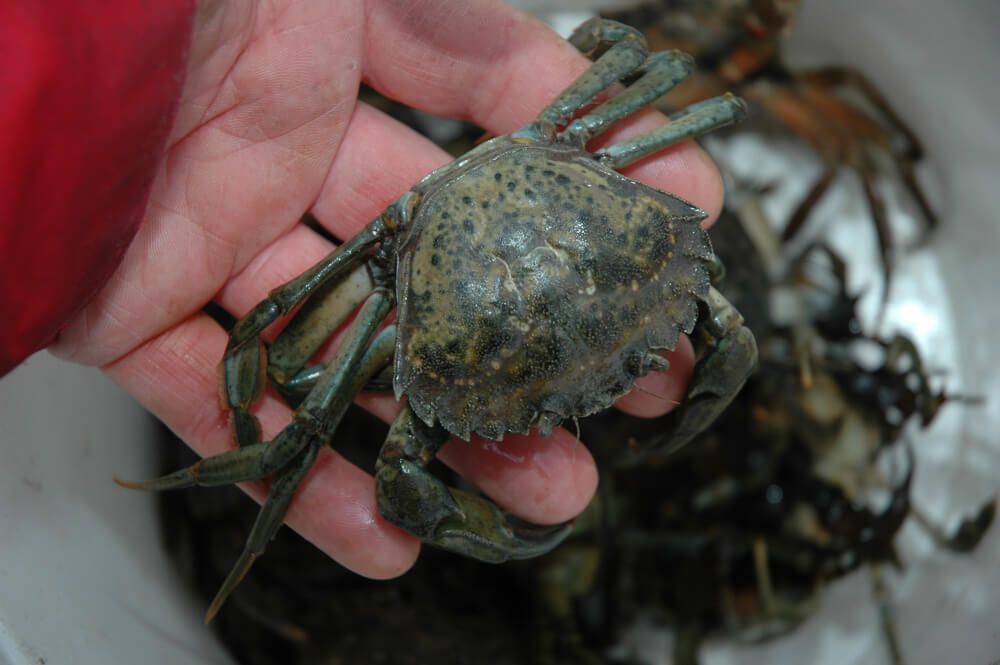
PEELING SEASON
Whilst the shore crab is a common sight twelve months of the year, the period it peels is governed by the warmth of the weather.
In Devon and Cornwall peelers can be found virtually right through the year, but numbers fall lowest during the colder months of January and February. In the West and Wales, expect the first crabs to peel from about mid March with peak peeling explosions in May and June, then again in September, with the last of the peelers picked in early November.
In the East, it's late April and into May before numbers are worth picking, and June is the real start of it for anglers in the Northeast and in Scotland. Early October at the latest is the usual end of the peeling season this far north.
It varies with the severity of the winter and spring. Cold weather delays the whole process and early frosts shorten the season.
THE PEELING PROCESS
Think in loose terms of the crab being opposite to a human. Whereas our soft outer bodies grow around a rigid inner skeleton the crabs internal organs grow inside a non growing outer shell. When this gets too small for the crab it has to be shed for the crab to continue growing.
The crab does this by extracting calcium from both the surrounding sea water and from it's old shell and creates a new initially soft shell which is formed in a corrugated fashion underneath the old shell. This extraction of calcium is why the old shell becomes brittle and falls away.
Just prior to actually peeling, the crab takes in large amounts of water which swells up the inner body by about 30% which literally forces the old shell free. The peel itself takes about 3 hours. The new shell hardens by consuming the left over calcium inside the body and also calcium from surrounding sea water. This hardening process takes between 4 and 6 days in summer, but can be as long as 16 days in the spring and autumn.
The juvenile crab moult up to 3 times a year, those approaching maturity only once a year, but once a crab fully matures the peeling cycle ceases.
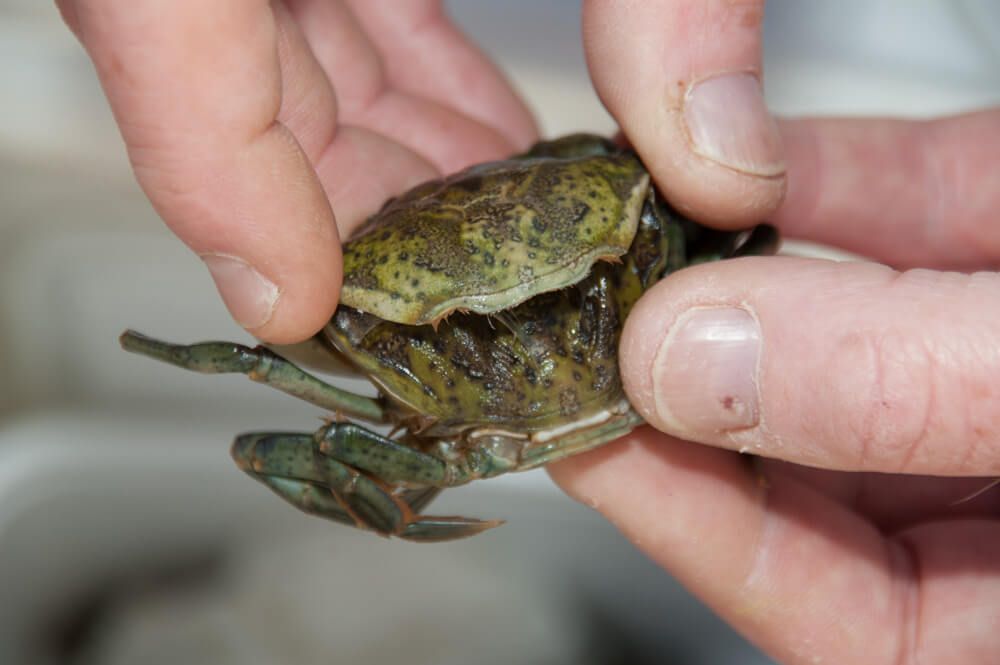
TELLING PEELERS FROM HARDBACKS
Peeler crab can be identified from hardbacks by nipping off the end segment of the rearward trailing leg. If a white tendon is left the crab is a hardback and no good for bait. If though, there is a soft new leg underneath the crab is a peeler and excellent bait.
More sophisticated ways to tell peelers from hardbacks are by running the ball of the finger over the back which feels soapy to the touch on a peeler, or by putting gentle pressure into the small of the crabs back and seeing if the shell is brittle and cracks which tells that the crabs shell is about ready to be shed and the crab a peeler. The colouration of a peeler crabs back and belly shell also goes dull and diffuse just prior to peeling.
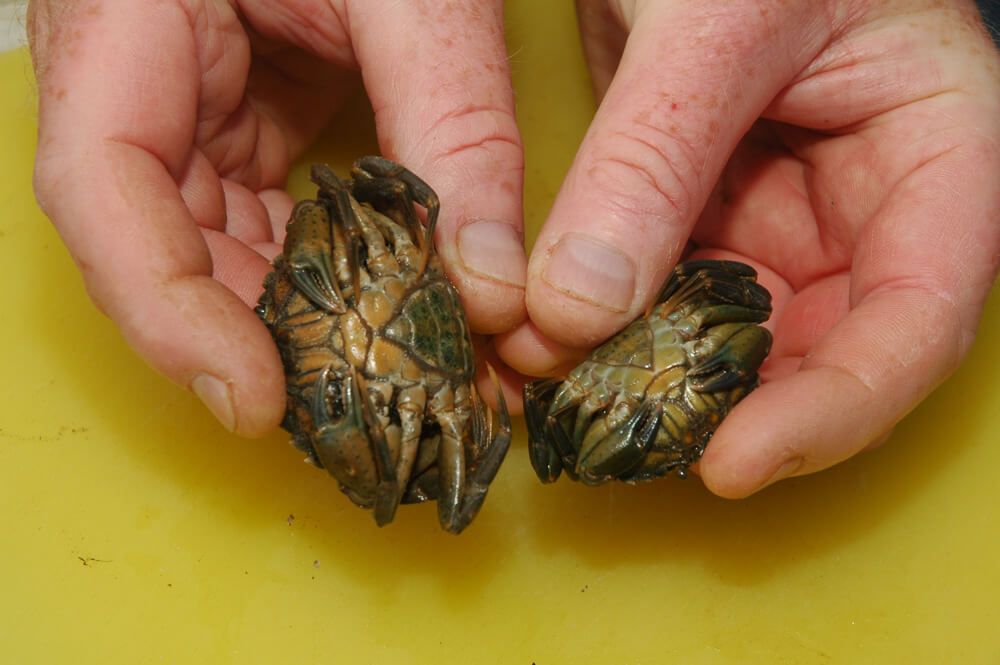
LOCATION
A very adaptable creature found along all our beaches amongst the rocks and under weed beds, buries itself for protection in clean sand around individual rocks, lives happily in the holes and weed growth along harbour walls and pier and jetty supports.
Takes refuge in paint cans, bits of waste tubing and guttering, under metal sheets and discarded washed up fertiliser bags, but is especially abundant in an estuary environment favouring the channel edges amongst rocks, weed, etc, and will even create crab colonies by burrowing in to mud banks.
Even working through the edges of clean sand gutters with a gloved hand or small three pronged hoeing fork along the edges of estuaries will turn up peelers buried in the sand, especially at the height of the peeling explosion when hiding places are at a premium.
COLLECTION
The commonest collection method is to work along the beach, estuary etc, turning over stones and weed until the crabs are revealed. However, the crab will often bury itself in the sand and mud underneath the stones and weed, so get into the habit of just working the fingers through the surface sand to feel for the crab. Often though, the give-away is that you can see the crabs eyes protruding through the surface. Finally, place the stone back exactly as you found it and you'll pick crab from there again. If you don't, the barnacles etc, that live under the stone die and pollute the immediate area keeping other crabs away.
Carrier crabs will walk up harbour walls and settle in the hanging weed. You can collect these by working a landing net vertically up and down the wall and into the weed scooping the crabs up as you go.
Another way is to lay a trap line. These can be staked out tyres, buried lengths of guttering, paint cans, etc, placed along the beach or estuary bank, all of which the crab will crawl into for protection whilst peeling takes place.
A messy, but very effective way to gather early spring peelers is to push your bare arm up to the elbow down the burrows and pull the crabs out living inside. Cuts, abrasions and covered in smelly mud maybe, but you pick peelers a good two weeks before their evident in the rocks.
The male crab will carry a female peeler underneath it until the female peels. Only when the peel has taken place the female is soft can breeding occur, hence the male crabs devotion. Any crab carried underneath another crab will be either a peeler or softie and good bait. A carried peeler will be facing downward underneath the male and a softie facing upward.
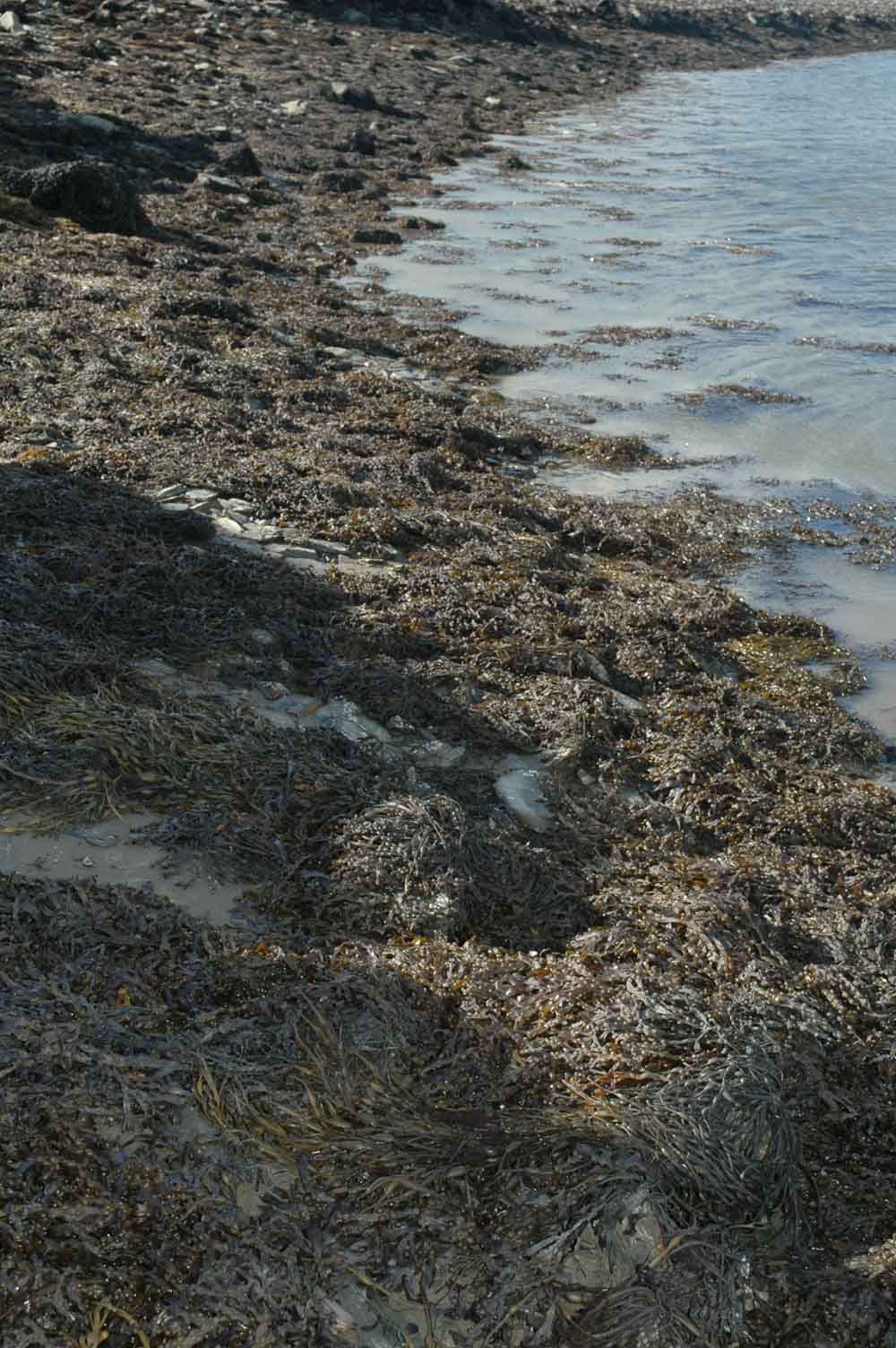
STORAGE
Successful storage of crabs is all about keeping them cool. You need a fridge set at 39 degrees Fahrenheit. Sort the crabs out into those that are very close to peeling (brittle shells) and those that will hang on a while.
Use plastic ice cream containers and similar putting fresh seaweed into each dampened with fresh sea water and put no more than 8 to 10 crabs in each one. Make sure that the lids are punctured to let oxygen in.
Every day check for and remove dead crabs, wash the seaweed in fresh sea water and replace them. They'll keep like this with only minimum casualties for at least a couple of weeks and with careful management as long as four weeks.
When transporting crabs for fishing trips, do so in a cool box with ice packs which keeps them in good condition and avoids wasted bait.
BRINGING CRABS ON
Those crabs that are in the early stages of peeling but do not have the brittle shell are okay for bait and do catch fish, but the nearer the crab is to actually peeling the better it is as bait. You can bring these slow developers on by taking them from the fridge and allowing them to acclimatise to normal air temperature, then placing them in fresh sea water that has been allowed to heat up to air temperature and letting them drink this in which triggers the peeling process. You'll see bubbles from their mouths as they soak up the water.
This is why it's essential to only damp the seaweed that you're keeping them in. If you let the ones you want to hold back have an occasional drink like is suggested by some anglers, the peeling process starts and you lose the crab.
BAIT PRESENTATION
Peel off all the shell and the legs so that you are left just with a soft body. You can peel the shell off the body, cut this in half and leave the legs on each side which go up the shank of the hook to disguise this and also to force the fish to bite at the hook point end. This is useful when bass hit the bait, run and drop it. Also for flounder, plaice and eels.
Peeler is full of scent. However, you need to maximise this scent, so always cut the whole crab down the middle, or in to quarters and bind them to the hook with a minimal amount of sheering elastic. Chunks quartered are excellent for eels, flounders, and plaice.
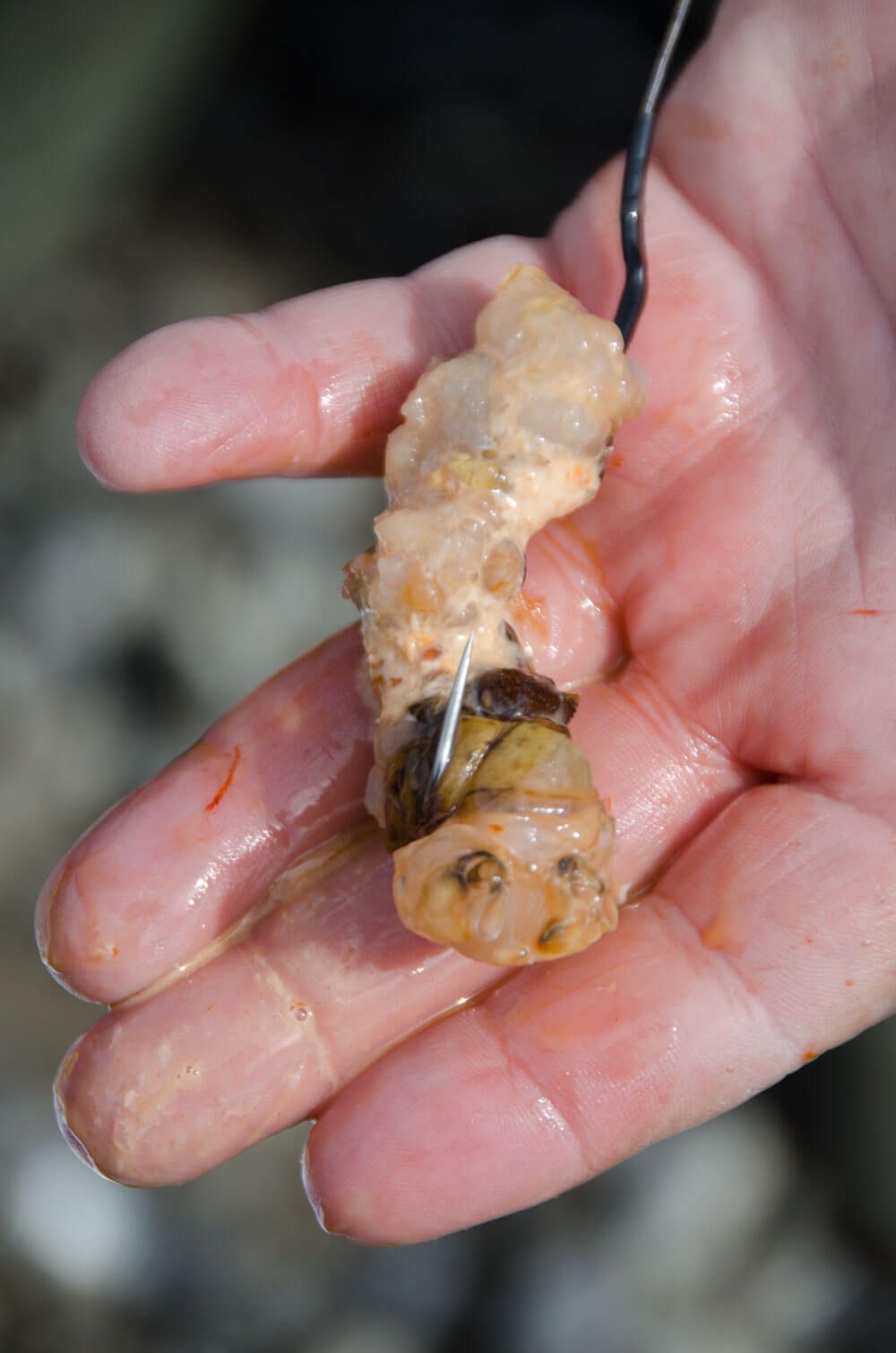
Big bass and cod like big baits, so instead of halving the crab, use scissors to cut the crab half way through towards the back, put the hook point into one side of the cut and then pull the hook around the crabs body until the point comes out opposite to where you started, then add the thread.
BUYING TIPS
When buying crabs from a shop, check that all are alive and slightly damp. If they are dry and few are moving there are likely to be many dead amongst them and the flesh deteriorating.
Try to buy crabs just after the spring tides begin to drop back to neaps. This means that crabs taken from high ground will have taken in fresh sea water before collection. Crabs can survive for several days without fresh sea water when living on higher ground but quickly die when stored in the fridge if picked before the high tides return. Some collectors and shops will put in a few hardbacks from time to time to make up the numbers. If they let you try to pick out your own crabs.
When a crab is about to shed it's old shell it is called a "Peeler" or "Shucker", "Softie" or "Jelly back" refers to crabs that have peeled and are waiting for the new shell to harden. "Walkers" is a name used for peeler crabs without mates. When a male crab carries the female underneath him they are called "Carriers". "Greenbacks" or "Hardbacks" are crabs not in the process of peeling and with hard shells.
IDENTIFICATION
The Shore Crab is the commonest variety of crab found around the UK shoreline. The shell is wide at the front with a series of bony serration's along the forward edge. The shell tapers inwards in a straight line towards the rear of the crab.
The colouration varies but is usually light to dark green with mottled darker patches for camouflage on the back. The belly varies between brownish orange to pale whitish green, depending on the type of ground the crab is living over.
The only other crab found over the same ground as the shore crab is the velvet swimmer which has a similar shape but the back of the shell is covered in like a velvet growth that instantly distinguishes the two apart.

PEELING SEASON
Whilst the shore crab is a common sight twelve months of the year, the period it peels is governed by the warmth of the weather.
In Devon and Cornwall peelers can be found virtually right through the year, but numbers fall lowest during the colder months of January and February. In the West and Wales, expect the first crabs to peel from about mid March with peak peeling explosions in May and June, then again in September, with the last of the peelers picked in early November.
In the East, it's late April and into May before numbers are worth picking, and June is the real start of it for anglers in the Northeast and in Scotland. Early October at the latest is the usual end of the peeling season this far north.
It varies with the severity of the winter and spring. Cold weather delays the whole process and early frosts shorten the season.
THE PEELING PROCESS
Think in loose terms of the crab being opposite to a human. Whereas our soft outer bodies grow around a rigid inner skeleton the crabs internal organs grow inside a non growing outer shell. When this gets too small for the crab it has to be shed for the crab to continue growing.
The crab does this by extracting calcium from both the surrounding sea water and from it's old shell and creates a new initially soft shell which is formed in a corrugated fashion underneath the old shell. This extraction of calcium is why the old shell becomes brittle and falls away.
Just prior to actually peeling, the crab takes in large amounts of water which swells up the inner body by about 30% which literally forces the old shell free. The peel itself takes about 3 hours. The new shell hardens by consuming the left over calcium inside the body and also calcium from surrounding sea water. This hardening process takes between 4 and 6 days in summer, but can be as long as 16 days in the spring and autumn.
The juvenile crab moult up to 3 times a year, those approaching maturity only once a year, but once a crab fully matures the peeling cycle ceases.

TELLING PEELERS FROM HARDBACKS
Peeler crab can be identified from hardbacks by nipping off the end segment of the rearward trailing leg. If a white tendon is left the crab is a hardback and no good for bait. If though, there is a soft new leg underneath the crab is a peeler and excellent bait.
More sophisticated ways to tell peelers from hardbacks are by running the ball of the finger over the back which feels soapy to the touch on a peeler, or by putting gentle pressure into the small of the crabs back and seeing if the shell is brittle and cracks which tells that the crabs shell is about ready to be shed and the crab a peeler. The colouration of a peeler crabs back and belly shell also goes dull and diffuse just prior to peeling.

LOCATION
A very adaptable creature found along all our beaches amongst the rocks and under weed beds, buries itself for protection in clean sand around individual rocks, lives happily in the holes and weed growth along harbour walls and pier and jetty supports.
Takes refuge in paint cans, bits of waste tubing and guttering, under metal sheets and discarded washed up fertiliser bags, but is especially abundant in an estuary environment favouring the channel edges amongst rocks, weed, etc, and will even create crab colonies by burrowing in to mud banks.
Even working through the edges of clean sand gutters with a gloved hand or small three pronged hoeing fork along the edges of estuaries will turn up peelers buried in the sand, especially at the height of the peeling explosion when hiding places are at a premium.
COLLECTION
The commonest collection method is to work along the beach, estuary etc, turning over stones and weed until the crabs are revealed. However, the crab will often bury itself in the sand and mud underneath the stones and weed, so get into the habit of just working the fingers through the surface sand to feel for the crab. Often though, the give-away is that you can see the crabs eyes protruding through the surface. Finally, place the stone back exactly as you found it and you'll pick crab from there again. If you don't, the barnacles etc, that live under the stone die and pollute the immediate area keeping other crabs away.
Carrier crabs will walk up harbour walls and settle in the hanging weed. You can collect these by working a landing net vertically up and down the wall and into the weed scooping the crabs up as you go.
Another way is to lay a trap line. These can be staked out tyres, buried lengths of guttering, paint cans, etc, placed along the beach or estuary bank, all of which the crab will crawl into for protection whilst peeling takes place.
A messy, but very effective way to gather early spring peelers is to push your bare arm up to the elbow down the burrows and pull the crabs out living inside. Cuts, abrasions and covered in smelly mud maybe, but you pick peelers a good two weeks before their evident in the rocks.
The male crab will carry a female peeler underneath it until the female peels. Only when the peel has taken place the female is soft can breeding occur, hence the male crabs devotion. Any crab carried underneath another crab will be either a peeler or softie and good bait. A carried peeler will be facing downward underneath the male and a softie facing upward.

STORAGE
Successful storage of crabs is all about keeping them cool. You need a fridge set at 39 degrees Fahrenheit. Sort the crabs out into those that are very close to peeling (brittle shells) and those that will hang on a while.
Use plastic ice cream containers and similar putting fresh seaweed into each dampened with fresh sea water and put no more than 8 to 10 crabs in each one. Make sure that the lids are punctured to let oxygen in.
Every day check for and remove dead crabs, wash the seaweed in fresh sea water and replace them. They'll keep like this with only minimum casualties for at least a couple of weeks and with careful management as long as four weeks.
When transporting crabs for fishing trips, do so in a cool box with ice packs which keeps them in good condition and avoids wasted bait.
BRINGING CRABS ON
Those crabs that are in the early stages of peeling but do not have the brittle shell are okay for bait and do catch fish, but the nearer the crab is to actually peeling the better it is as bait. You can bring these slow developers on by taking them from the fridge and allowing them to acclimatise to normal air temperature, then placing them in fresh sea water that has been allowed to heat up to air temperature and letting them drink this in which triggers the peeling process. You'll see bubbles from their mouths as they soak up the water.
This is why it's essential to only damp the seaweed that you're keeping them in. If you let the ones you want to hold back have an occasional drink like is suggested by some anglers, the peeling process starts and you lose the crab.
BAIT PRESENTATION
Peel off all the shell and the legs so that you are left just with a soft body. You can peel the shell off the body, cut this in half and leave the legs on each side which go up the shank of the hook to disguise this and also to force the fish to bite at the hook point end. This is useful when bass hit the bait, run and drop it. Also for flounder, plaice and eels.
Peeler is full of scent. However, you need to maximise this scent, so always cut the whole crab down the middle, or in to quarters and bind them to the hook with a minimal amount of sheering elastic. Chunks quartered are excellent for eels, flounders, and plaice.

Big bass and cod like big baits, so instead of halving the crab, use scissors to cut the crab half way through towards the back, put the hook point into one side of the cut and then pull the hook around the crabs body until the point comes out opposite to where you started, then add the thread.
BUYING TIPS
When buying crabs from a shop, check that all are alive and slightly damp. If they are dry and few are moving there are likely to be many dead amongst them and the flesh deteriorating.
Try to buy crabs just after the spring tides begin to drop back to neaps. This means that crabs taken from high ground will have taken in fresh sea water before collection. Crabs can survive for several days without fresh sea water when living on higher ground but quickly die when stored in the fridge if picked before the high tides return. Some collectors and shops will put in a few hardbacks from time to time to make up the numbers. If they let you try to pick out your own crabs.

